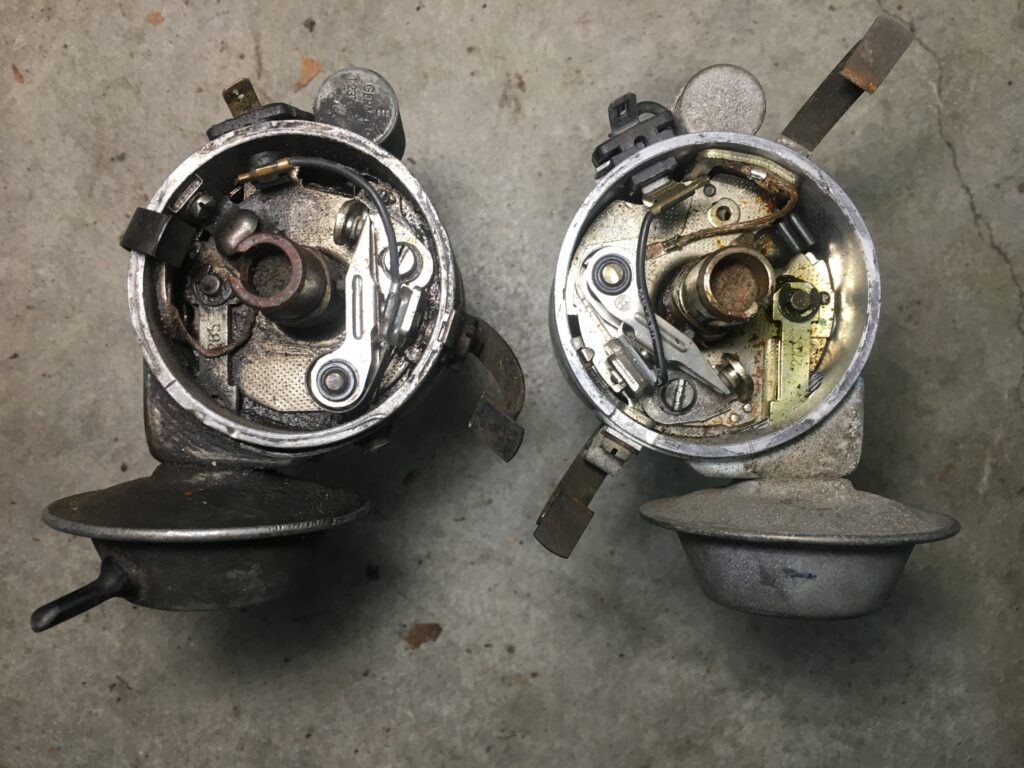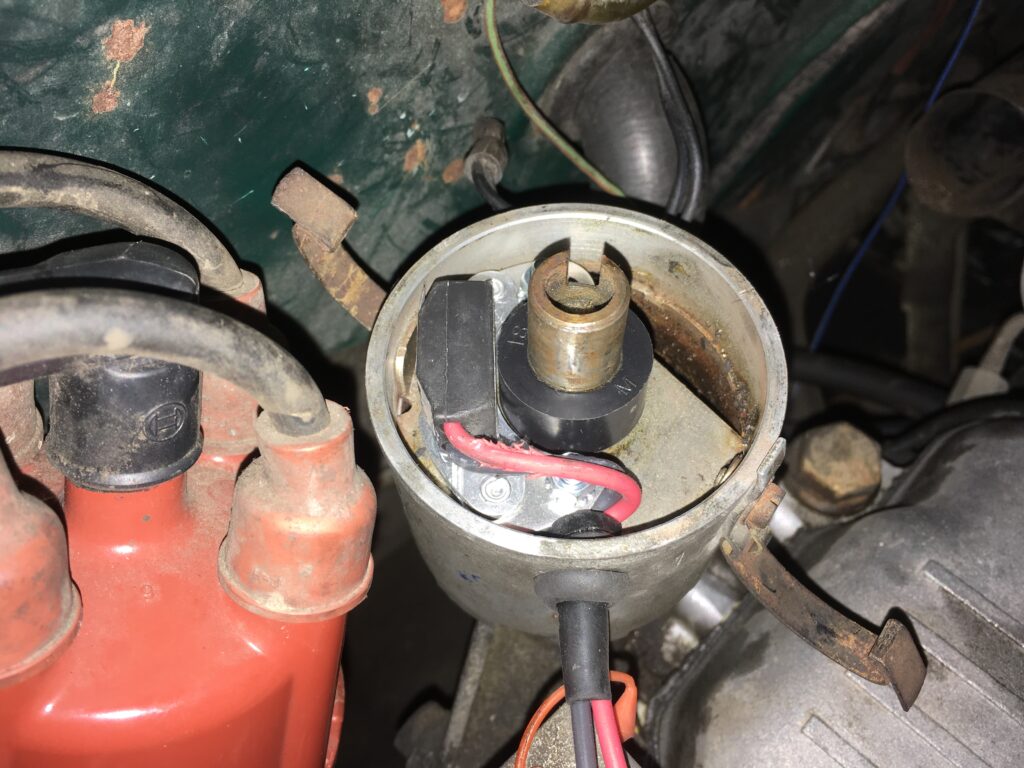About ten years ago, I had an issue with “Kugel,” my departed ’72 tii. I’d just treated it to a new ignition system—freshly-rebuilt distributor, new points / condenser / cap / rotor, new Bosch red coil and ballast resistor, new plugs and wires. The car ran well for a few miles, then stumbled so badly that I barely made it home. I couldn’t figure it out, and posted my frustration on Facebook.
My friend Lindsey Brown, shop foreman at The Little Foreign Car Garage in Waltham, one of the administrators of the 2002 FB group, and lifelong 2002 guy, replied “Can I come over and play?” About an hour later, he showed up with a distributor and other ignition parts.
“These,” he said, “are known-good. I pulled them from my 2002 this morning. Let’s swap them until we find which of your components is bad.”
I protested, especially regarding pulling the distributor. I’d just had it rebuilt, and I’d replaced all of the normal-wear-and-tear tune-up parts with new BMW parts. It simply wasn’t possible that there was anything wrong with it. How, I asked, could his distributor be more “known-good” than mine?
Lindsey stared at me and asked rhetorically “Are you having a problem or aren’t you?”
“Well… yes,” I sheepishly acquiesced, while mumbling “known good my ass.”
We first swapped in his coil, ballast resistor, and plug wires. No difference.
Then we set the engine to top dead center, verified that the rotor pointed approximately at the notch in the rim of the distributor, pulled the distributor, dropped his in, and statically ballparked the timing.
The car started immediately. I was dumfounded.
“Now,” Lindsey said, “We’ll swap the distributor components until we find out which one is causing the problem.”
It was the condenser—a brand-new one that came from a BMW dealer in a BMW-logo’d box with a BMW part number on it.
That was ground zero for two lessons. The first was the knowledge that many new parts are absolute garbage. It doesn’t matter if they’re Original Equipment (OE, “Genuine BMW”) or Original Equipment Manufacturer (in this case, Bosch). The volume of vintage-car-specific parts like points and condensers that BMW / Bosch produces is insignificant compared with parts for new under-warranty cars that the manufacturer will have to eat the cost for if they fail. Numerous friends have bad condenser experiences like mine, or experienced the joy of having the little nylon block that opens up the points break off, causing them to remain closed, which drags the car immediately into the breakdown lane. This is one of the big reasons why, in the big points-versus-Pertronix debate, I come down firmly on the electronic triggering (Pertronix) side. Another big reason is that due to pitting of the contact faces and wear in the nylon block, points eventually close up over time. This increases the dwell, which causes the ignition timing to retard. In contrast, with electronic triggering, dwell and timing remains constant. Kugel was the first of about half a dozen cars that I installed a Pertronix electronic triggering module into.

The combatants in the eternal debate of points-and-condenser versus an electronic triggering module like a Pertronix.
But the other lesson was that, although Lindsey’s point that a distributor pulled from his running-just-this-morning car had a validity that the newly-rebuilt-and-stuffed-with-new-parts one in my dead car was lacking, there really is no such thing as “known-good.” There are only symptoms and whether they change when a suspect part is swapped. It doesn’t matter whether or not the part is new. I recall arriving at The Vintage in Asheville one year and helping Odometer Gears owner Jeff Caplan diagnose a charging problem in his 2002. The car had a newly-rebuilt Bosch alternator and a new solid-state voltage regulator in it, and both turned out to be bad. Whenever you or someone else says “Well, I just replaced X so it can’t be that,” a flag should go up that you’ve just inserted a blind spot into your ability to reason your way through a diagnosis.
And so, with that, we come to Hampton, my 49,000-mile survivor ’73 2002. As I wrote about here, as a little winter project last month, I replaced the original weird non-reversed-points smog-compliant vacuum-retard distributor with a earlier standard vacuum-advance unit. When I did that, due to both wanting to keep the original distributor intact just in case I needed to swap it back in and the fact that the condenser hole in the original dizzy was square but the one in the replacement was round, I installed a new set of Bosch points and condenser that came with a parts hoard I’d inherited. I statically timed it to get it in the ball park, made sure the car started, then put it away.

Out with the original (rght), in with the replacement (left).

But with a shiny new condenser on it that I should have known might cause me trouble.
So when spring came and a few days of rain had washed the salt off the roads, the first thing to do with Hampton was set the dwell and timing. I pulled out my old-school dwell meter and the timing light, then started the car. Hampton has had a long-standing starting issue that’s over and above the usual dry float bowl from sitting. It’s likely caused by something in the warm up and idle circuit that never got cleaned out after the car sat in a barn for ten years. But after a blast of starting fluid and time to warm up, it’s always been fine. I dialed in the dwell to about 60°, used the advance timing light to set the total advance to about 35°, and took the car for a drive, hammering on the gas to listen for knocking.
All seemed good until I was about a quarter mile from the house when the car lost power and barely ran. I limped it home and back into the garage. I checked all the electrical connections to the coil, the plug wires, and the cap and rotor, and verified that the points were opening and closing and that the screw holding the condenser to the body of the dizzy (the condenser’s ground path) was snug.
Then I remembered that I’d installed that new set of points and condenser in the distributor when I swapped it in last month, and realized that that made the condenser suspect. I hunted around in my box of old ignition parts (I never throw stuff like this away), found a condenser with a plug for a round hole, and installed it in the distributor.
Vroom.
I know that, despite the known issues with points-and-condenser ignition systems, some folks prefer them due to the originality, vintage charm, and the ease of diagnosis, and are uncomfortable with electronic triggering due to their “black box that either works or it doesn’t” nature. I have one friend who claims that his tii didn’t like the Pertronix and swears it runs better with points. I get it. I tried installing a Pertronix in my Bavaria, and for unknown reasons, the car lost its ability to rev above 5,000 rpm and I had to reinstall the points.
But I’ve had Pertronix systems in multiple 2002s that have logged probably 15,000 miles back and forth to The Vintage and MidAmerica 02Fest over the years, and have never had so much as a hiccup. I also have a Hot Spark module in one car, and it too has performed flawlessly. The only failures I’ve had were pre-trip installation mistakes that were my own fault. One was where I accidentally switched the red and black (hot and ground) wires, which blew the thing up instantly. The other was when I didn’t follow Pertronix’ instructions about being certain that there’s at least 3 ohms of resistance across the coil and the ballast resistor, which means that you can run it with a Bosch blue coil which already has 3 ohms of internal resistance and thus doesn’t need a ballast resistor, or you need the red coil and red resistor or the original black coil and white resistor. I did once troubleshoot someone else’s car who said that his Pertronix had failed and was only running on one cylinder. I found that the module wasn’t a Pertronix but an unbranded knock-off, and that when he’d pulled the magnetic ring off the distributor shaft, it had come apart and dropped three of the four triggering magnets into the distributor. I suspect that many of the online complaints about Pertronix are either due to incorrect resistance or that the module is actually a knock-off made by someone else.

You can stay with points-and-condenser systems. For road trips, I’ll still put my faith in electronic triggering.
If I do road-trip Hampton this spring, a Pertronix or Hot Spark is going in. I’ve been taught this lesson enough times that this time, it really should stick.
—Rob Siegel
____________________________________
Rob’s newest book, The Best of The Hack Mechanic, is available here on Amazon, as are his seven other books. Signed copies can be ordered directly from Rob here.
Tags: 2002 car parts Hack Mechanic repair




















